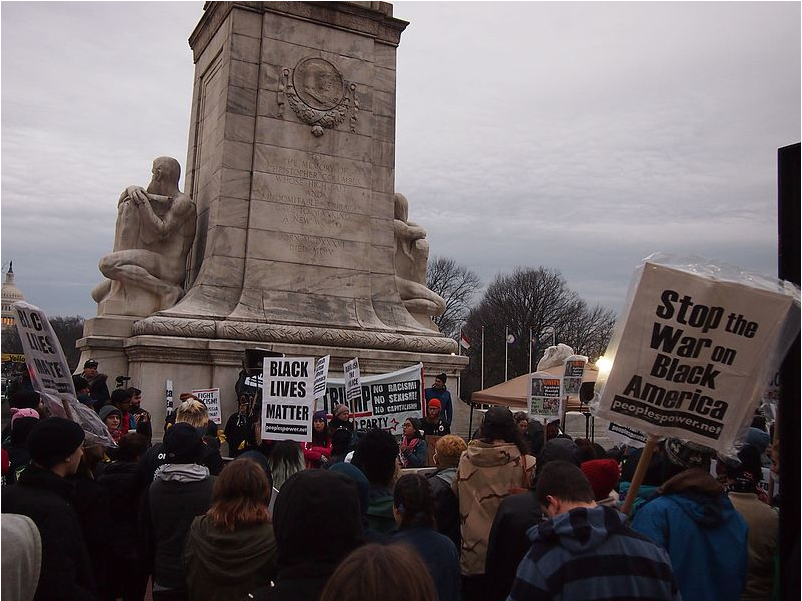With or Without White Allies – Racial Conflict in America
Slowking3 / Wikimedia Commons
Thousands protested in Jan. 2017 at what became known as the “Women’s March”. Many of the protesters also supported the Black Lives Matter movement. These protesters gathered at the monument to Christopher Columbus near the Capitol building in Washington, DC. The march was repeated this year, and again contained many protesters supporting the BLM movement, along with dozens of other causes.
As a SENIOR at WHHS who has been here since seventh grade, I am no stranger to the diversity our institutions boasts, and rightfully so. Diversity is progressive and encourages improved race relations. But one thing I have learned in these six years is that people tend to give themselves too much credit when they feel that diversity has been achieved.
WHHS has made it clear to me that on a smaller scale, race relations can not improve based on diversity alone, for diversity is simply an opportunity to grow and learn. The desired results of diversity vary depending on our how much we care to take advantage of this opportunity, and on a larger scale, America’s state of racial relations reflects that we care very little.
When discussing racism, it is important to acknowledge the presence of systematic oppression. For generations, African-Americans have transformed and rebranded the fight equality. Progress has been made, but it is possible to win battles while losing the war. The primary privilege granted to white Americans is that if they choose not to acknowledge the issue with race in our country, then it simply does not exist.
Those benefiting from the uneven distribution of power and privilege present in our society must care about issues that do not affect them or issues from which they benefit.
This is where the idea of white allies resides, from white abolitionists in the 1860s to government interference in the civil rights movement. But the popular opinion among the majority of white people is that equality for African-Americans is not a priority.
In a country where the Justice Department classifies Black Lives Matter as a “black identity extremist group”, many see the idea of racial equality as radical.
Among the many causes for racial equality created by black people, Black Lives Matter’s message is one of the most diluted. Given the disproportionate amount of injustice inflicted the black community, it is hard to understand why a rudimentary statement like “black lives matter” causes so much controversy. Dismissing Black Lives Matter based on this statement alone exposes prejudice and hinders the fight for equality.
To change the minds of an entire race is a utopian solution. I could come up with dozens of clever metaphors or anecdotes illustrating how racism in America oppresses minorities, but it is impossible to simulate a social construct that is 400 years in the making. The lack of awareness has proved extremely detrimental to our democratic society, but it is in no way my job as an African American to lend my existence to teaching white people how to empathize with those without the privileges they possess.
There is also the issue of problems within the African-American community only being addressed or broadcasted when they coincide with popular culture. I struggled to find an angle to this article that would make students want to read this lengthy piece and see the topic as something that is worthy of being addressed. We either move on too fast from the hand full of stories that make headlines, or the media does not care to broadcast certain instances of injustice.
The reality is that the need for justice does not stop once society gets over H&M’s racially insensitive advertisements that reveal a lack of black voices within their corporation, or after President Trump makes disrespectful comments about predominantly black countries. Racism does not disappear once the most recent case for the murder of a black individual at the hands of law enforcement closes.
Our fast-paced lifestyles have awarded the us the opportunity to collectively not care about racism until it becomes a profitable, “relevant” topic. This is problematic because for many of those who are not subjected to the experience of a black person in America, they only have to address racial conflict when the media feeds the information to them.
But much like diversity, awareness is only an opportunity to make a change, and what people do with that information determines how successful we are in improving America’s race relations. Diversity fails in the form of high school cliques and the bare minimum done by PWIs (Predominantly White Institutions) to include minorities. Awareness fails in that despite all the information and statistics available, opinions and preconceived notions often trump facts (pun intended), especially in topics as sensitive as race.
But what leverage do we have to get other people to empathize with us? There are virtually no tangible incentives for other POCs and white people to care about the rights of African Americans. The idea that history repeats itself is most prevalent in how long African Americans have navigated through a society riddled with systemic injustices.
Ignorance of the majority debilitates the rights of minority. Bettering race relations involves awareness, accountability and acknowledgement of the privileges granted to white Americans.
Your donation will support the student journalists of Walnut Hills High School. Your contribution will allow us to purchase equipment, cover our annual website hosting, printing costs and offset competition and conferences fees for students.








